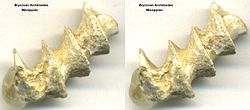Paleofauna
Early work aimed at creating a comprehensive list for all fossils found in the Pitkin Formation was done by Easton in 1943. [1] Unless otherwise stated, all species below can be found in his 'Fauna of the Pitkin Formation.'
Foraminifera
- A. stilus [5]
- A. rugosus [5]
- Eostaffella [5]
- Eotuberitina [5]
- Monotaxinoides [5]
- Neoarchaediscus [5]
- Nodosarchaediscus [5]
- Paramillerella [6]
- Planospirodiscus [5]
- Plectogyra [6]
- Priscella [5]
- Pseudoammodiscus
- P. priscus [5]
- T. corona [6]
Porifera, Sponges

Scyphozoa
- Conularia Originally considered to be a gastropod.
Anthozoa, Corals
- Aulopora from the Silica Formation of Ohio.
- Pleurodictyum americanum from the Givetian Kashong Shale (Hamilton Group) of Livingston County, New York.
- Syringopora from the Boone Formation of Arkansas.
Blastoidea

- P. elongatus [9]
- P. godoni [9]
- P. laminatus [9]
- P. obesus [9]
- P. platybasis [1]
Crinoidea, Sea Lilies
- Agassizocrinus (see unidentified section)
- A. patulus [10]
- A. planus [10]
- B. figuratus [10]
- C. stevensi [10]
- C. eventus [10]
- L. floweri [10]
- O. pulaskiensis [10]
- P. pitkini [10]
- P. stereostoma [10]
- P. modulus [10]
- P. tridecibrachiatus [10]
- Scytalocrinus (see unidentified section)
- T. whitfieldi [10]
- T. caespes
- T. residuus
- Z. foveatus
- Cyathocrinus goniodactylus, on display at Galerie de paléontologie et d'anatomie comparée in Paris.
- Fossil of Scytalocrinus from Carboniferous of the United States
Ophiuroidea, Brittle Stars
This group was originally place under Stelleroidia in early studies. [1]
- A. singulatus
Echinoidea, Sea Urchins

Worms
Previous studies have grouped these diverse animals into a single, obsolete taxon: Vermes. [1]
Bryozoa, "Moss-animals"
| Stereo image | |||
|---|---|---|---|
| |||
| |||
| |||
| |||
| Fossilized skeleton of Archimedes Bryozoan. | |||
- A. solida [1]
- Archimedes (called Archimedipora in early studies) [1]
- A. communis [1] [11]
- A. compactoides [11]
- A. compactus [11]
- A. distans [1] [11]
- A. fosteri [11]
- A. fragilis [11]
- A. intermedia (A. intermedius) [1] [11]
- A. invaginata (A. invaginatus) [1] [11]
- A. lunatus [11]
- A. magnus [11]
- A. meekanus [11]
- A. moorei [11]
- A. pitkinensis [11]
- A. proutana (A. proutanus) [1] [11]
- A. sublaxus [11]
- A. swallovana (A. swallovanus) [1] [11]
- A. terebriformis [11]
- C. distans [11]
- C. regularis [1]
- P. whitei [1]

Brachiopoda
- A. suspectum [12]
- A. cestriensis
- B. arkansana
- C. cestriensis
- C explanata
- C. oklahomensis
- C. sericeus
- C. tumescens
- Cliothyridina
- C. sublamellosa
- Composita (See unidentified section)
- C. subquadrata
- C. trinuclea
- C. infimbriata
- D. arkansanum
- D. formosum
- D. illinoisensis
- D. shumardanum
- D. whitfieldi
- Echinoconchus (See unidentified section)
- E. alternatus
- E. costata
- E. pitkinensis
- E. vera
- G. indianensis
- H. multicostata
- K. lucerna
- L. newberryi var. moorefieldana and ovata
- L. pileiformis
- O. kaskaskiensis
- O. stenopsis [12]
- O. subglobosus (var. protensa)
- O. uspectum
- P. cestriensis
- P. fasciculatus
- R. setigera
- S. leidyi
- S. pellaensis
- S. spinosa
- S. aequalis
- T. neogenes
Bivalvia, Bivalves
This group was also referred to by another name in earlier studies: Pelecypoda . [1]
- A. walkeri
- A. batesvillensis
- A. eurekensis
- A. keoughensis
- A. morrowensis
- A. multilineatus
- A. pitkinensis
- C. peculiare
- Cypricardella (See unidentified section)
- Edmondia
- E. crassa (Along with E. crassa var. suborbiculoidea)
- E. pitkinensis
- L. vaseyana
- Leiopteria
- Leptodesma
- Myalina
- M. compressa
- M. longicardinalis
- N. illinoisensis
- Parallelodon
- Pteronites
- Schizodus (See unidentified section)
- S. arkansanus
- S. chesterensis
- S. depressus
- S. insignis
- S. cherokeense
- S. gibsonense
- S. quadriplicatum
Scaphopoda, Tusk Shells
Gastropoda, Snails
- Bellerophon (See unidentified section)
- B. pitkinensis
- Bucanella
- Colpites
- Euphemites
- E. incarinatus
- Clabrocingulum
- Gosseletina (See unidentified section)
- Helcionopsis
- H. reticulatus
- H. newtonensis
- Latischisma
- Leptoptygma (See unidentified section)
- Microptychis
- Mourlonia
- M. angulata
- P. subrotundum
- S. subcorpulenta
- S. planidorsatus
- S. triliris
- Strobeus (See unidentified section)
- Strophostylus
Cephalopoda
- A. furnishi [13]
- Coloceras (see unidentified section)
- Cravenoceras
- C. hesperium
- C. richardsonianum [13]
- C. randolphensis
- C. equoyahensis
- Dolorthoceras (See unidentified section)
- D. eurekensis
- E. globosus
- E. bisulcatum [13]
Trilobita
- G. pustulosus
- K. chesterensis
- K. pitkinensis [14]
- P. mucronatus
Ostracoda
- G. optina
- P. fayettevillensis
Vertebrata
Plantae, Plants
"Encrusting Algae" has been reported but not assigned to any genus. [1]
- A. cordillerensis [5]
Unidentified
Following is a list of fossils also found in the Pitkin by Easton in 1943 that have gone unidentified. [1]
- A "Cup Coral"
- A member of the genus Pentremites
- Three species within Agassizocrinus
- Two species within Scytalocrinus
- A totally unidentifiable Crinoid
- Two species of Bellerophon
- Two species of Gosseletina
- Two species of Leptoptygma
- Two Species of Strobeus
- One species each of Composita and Echinoconchus
- Two species of Cypricardella
- Two species of Coloceras, one of which may actually be Leuroceras
- One species of Dolorthoceras
- An unnamed shark spine





